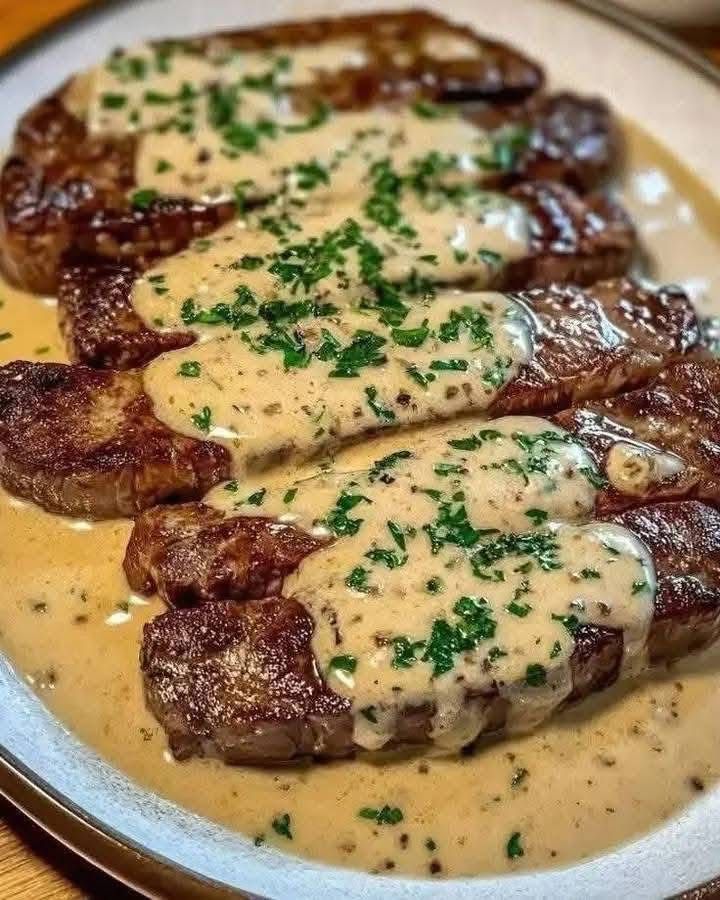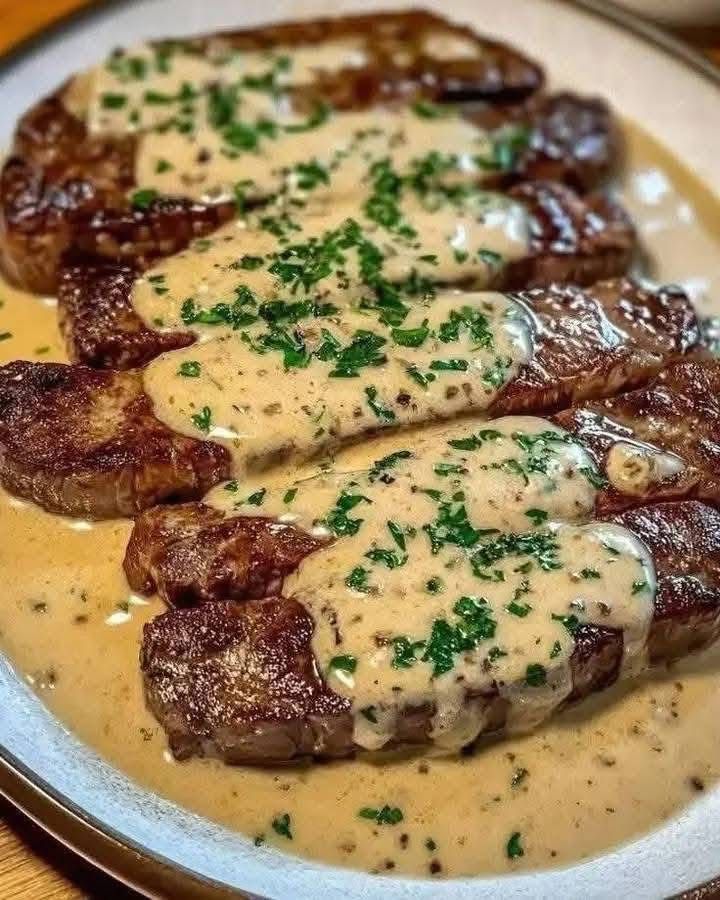Ingredients
For the Steak:
- 4 ribeye or sirloin steaks (about 1 inch thick)
- Salt and freshly ground black pepper to taste
- 2 tablespoons olive oil
- 2 tablespoons butter
- 2 cloves garlic, crushed
- 1 sprig of fresh rosemary or thyme (optional)
For the Creamy Garlic Sauce:
- 1 tablespoon butter
- 5 cloves garlic, minced
- 1 cup heavy cream
- 1 teaspoon Dijon mustard (optional)
- 1/2 teaspoon crushed black pepper
- 1/4 cup grated Parmesan cheese
- Salt to taste
- Fresh chopped parsley for garnish
Instructions
Step 1: Prepare the Steaks
- Remove steaks from the refrigerator and let them come to room temperature for about 30 minutes.
- Pat them dry with paper towels. Season generously with salt and black pepper on both sides.
Step 2: Sear the Steaks
- Heat olive oil in a large heavy skillet (cast iron preferred) over medium-high heat.
- When the pan is hot, add the steaks and sear for 3 to 4 minutes per side for medium-rare, or until desired doneness.
- In the last minute of cooking, add butter, garlic cloves, and rosemary or thyme.
- Tilt the pan and spoon the melted butter over the steaks for extra flavor.
- Remove the steaks and let them rest on a plate covered loosely with foil.
Step 3: Make the Creamy Garlic Sauce
- In the same pan, reduce heat to medium and add 1 tablespoon butter.
- Add minced garlic and cook for 30 seconds until fragrant.
- Pour in the heavy cream and stir to combine.
- Add Dijon mustard if using, and crushed black pepper.
- Let the sauce simmer gently for 3 to 5 minutes until slightly thickened.
- Stir in Parmesan cheese and season with salt to taste.

Step 4: Combine and Serve
- Return the steaks to the pan or pour the sauce over them on a serving platter.
- Spoon sauce generously over the steaks.
- Garnish with chopped fresh parsley.
- Serve hot with mashed potatoes, roasted vegetables, or crusty bread.
Juicy Steak with Creamy Garlic Sauce: A Deep Dive into Technique, Flavor, and History
Steak is one of the most iconic and satisfying meals in the world of culinary arts. When prepared correctly, it embodies richness, simplicity, and refinement all at once. Adding a creamy garlic sauce to a perfectly seared steak elevates the dish even further, combining the robust, savory depth of the beef with the luxurious texture of a cream-based sauce. This combination is not just a recipe; it is a celebration of balance between bold protein and delicate dairy.
Understanding how to master this dish is more than following steps. It involves appreciating ingredients, perfecting techniques, and knowing the reasons behind each action. The goal is not only to serve food but to create a complete sensory experience.
The Importance of Choosing the Right Cut
The foundation of any great steak dish begins with choosing the right cut. Ribeye and sirloin are excellent options due to their marbling and texture. Ribeye is known for its rich fat content and tenderness, while sirloin offers a leaner yet still flavorful alternative. Cuts like filet mignon or New York strip can also work, depending on preference.
Thickness matters too. A steak that is too thin will overcook quickly and lack a seared crust. A steak that is at least one inch thick gives enough room to develop a crust while keeping the interior juicy and tender.
Quality of the meat also plays a role. Choosing well-sourced, aged beef can make a noticeable difference in taste. A high-quality steak does not require excessive seasoning or marinating. Salt and pepper are often enough to enhance its natural flavor.
The Science of Searing
Searing is not just about color. It is a chemical process known as the Maillard reaction, where proteins and sugars in the meat interact under high heat to create complex flavors and aromas. This crust is essential for the steak’s overall character.
To achieve the perfect sear, the steak must be dry. Any moisture on the surface will create steam and prevent browning. Letting the meat rest at room temperature before cooking helps it cook evenly and promotes better browning.
The skillet must be hot enough before adding the meat. Using cast iron is ideal because it retains heat and provides consistent searing. Once the steak hits the pan, it should not be moved for a few minutes. This ensures an even crust forms. Turning it only once keeps the juices locked inside and the texture consistent.
Basting the steak with butter, garlic, and herbs in the final moments of cooking adds flavor and aroma. It also prevents the crust from drying out and enhances richness.
Resting the Meat
After searing, it is crucial to let the steak rest. Cutting into it immediately will release the juices that have built up during cooking, leaving the meat dry. A short resting time of about five minutes allows the juices to redistribute throughout the meat. This results in a tender, juicy interior that is flavorful from edge to center.
Building the Garlic Cream Sauce
Creamy sauces have long been associated with indulgence and finesse. The garlic cream sauce used in this recipe is simple yet incredibly powerful in flavor. It begins with butter and garlic, forming a rich aromatic base. Garlic should be cooked gently, not browned, to avoid bitterness and maintain a sweet, mellow flavor.
Heavy cream creates the luxurious body of the sauce. As it simmers, it thickens and takes on the flavor of the garlic and pan drippings. Dijon mustard, while optional, adds subtle complexity and tang. Parmesan cheese contributes saltiness and umami, making the sauce deeper and more robust.
This sauce does not need flour or starch to thicken. The reduction process and the addition of cheese naturally bring it to the perfect consistency. Seasoning at the end ensures that the sauce is balanced and does not overpower the steak.
The Balance Between Sauce and Meat
The key to this dish is harmony. The creamy garlic sauce should enhance the steak, not drown it. Too much sauce can cover the flavor of the beef, while too little can feel incomplete. A well-portioned drizzle over each steak gives contrast without overwhelming.
The texture of the steak contrasts with the smoothness of the sauce. This duality creates a more satisfying mouthfeel and allows the individual components to shine.
Serving the sauce either poured over the steak or on the side offers flexibility. In a formal setting, plating the steak with sauce artistically drizzled adds visual appeal. For casual meals, placing everything in one pan for family-style serving emphasizes comfort and simplicity.
Accompaniments and Pairings
This dish pairs well with a variety of side options. Mashed potatoes are a classic choice, offering a neutral base that absorbs the sauce. Roasted or steamed vegetables such as asparagus, green beans, or carrots provide color and texture. Crusty bread can also be served to mop up the sauce.
For beverages, red wine such as Cabernet Sauvignon, Syrah, or Merlot complements the richness of both steak and sauce. For non-alcoholic options, sparkling water with lemon or a dark grape juice works well.
Cultural Influence and Evolution
Steak with cream sauce is a timeless dish seen in many cuisines. French cuisine, known for its sauces, often pairs steak with béarnaise or peppercorn cream sauces. Italian variations may use gorgonzola or mushroom-based sauces. American steakhouse menus frequently include garlic cream or blue cheese toppings.
Despite regional variations, the idea remains the same: enhancing beef with a rich, flavorful sauce. This version, using garlic as the key flavor note, appeals to a broad audience. Garlic is universally appreciated, and when used properly, it creates a sauce that is aromatic, sweet, and savory all at once.
Cooking at Home vs. Dining Out
One of the advantages of preparing this dish at home is control. You can select the quality of your ingredients, customize the sauce, and cook the steak to your exact preference. Restaurant versions may rely heavily on butter or salt. At home, you can adjust for dietary needs or personal tastes.
It is also more affordable to enjoy high-quality steak at home. While a dish like this might cost significantly more in a steakhouse, preparing it yourself brings both economic and emotional value. Sharing it with family or guests adds to the satisfaction of the experience.
Final Reflections
Juicy steak with creamy garlic sauce is more than just a meal. It is a statement of skill, taste, and appreciation for simple ingredients treated with care. It combines rustic appeal with culinary elegance, making it suitable for everyday dinners or special occasions.
Learning to prepare this dish well builds confidence in cooking techniques like searing, resting meat, and making pan sauces. These are foundational skills that can be applied across countless other recipes.
The contrast between the caramelized crust of a steak and the smooth richness of garlic cream creates a memorable flavor experience. Every bite should offer warmth, boldness, and comfort. That is the true essence of this dish. It brings people together around a table, offering not just nourishment but pleasure in every mouthful.
